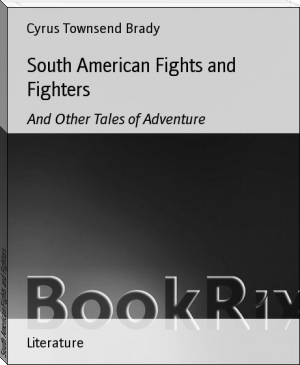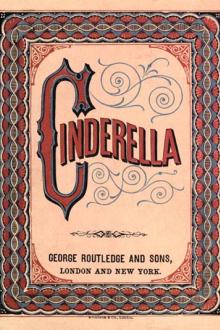South American Fights and Fighters, and Other Tales of Adventure by Brady (rosie project .txt) 📕

Read free book «South American Fights and Fighters, and Other Tales of Adventure by Brady (rosie project .txt) 📕» - read online or download for free at americanlibrarybooks.com
- Author: Brady
Read book online «South American Fights and Fighters, and Other Tales of Adventure by Brady (rosie project .txt) 📕». Author - Brady
Parnell's company immediately began the escalade of the cliffs. Madigan had not been so fortunate. Where he struck the ravine the wall happened to be absolutely sheer. Descent was not practicable. His men therefore stopped on the brink until he directed his infantrymen to circle the ravine until they found a {308} practicable descent and there join Parnell's men. He had scarcely given the order when a bullet pierced his brain. Some of his men were also struck down, others retired behind the rocks, made a detour and followed Parnell.
The sides of the ravine were so precipitous that no man could scale them unaided. Two or three would lift up a fellow-soldier. After gaining a foothold he in turn would pull others up, and thus they slowly made their way to the edge of the cliffs, Crook climbing with the rest. They finally gained the banquette, or platform, after a difficult and exhausting climb. The Indians were behind the walls of the fort, the soldiers outside. Sergeant Michael Meara, leading the advance, peeped through a loop-hole, and was shot dead. Private Willoughby Sawyer, happening to pass by another orifice, was killed in the same way. In both cases the Indians were so close that the faces of both men were badly powder burned. A slug struck the wrist and an arrow pierced the body of Private Shea, hurling him to the bottom of the ravine.
But the soldiers were not idle. Guns from each side were thrust through every loophole or crevice and discharged blindly. In this desperate method of fighting, the Indians, being contracted within the circle, suffered the more. While some were fighting thus, others were tearing down the rocky wall with hands and bayonets. A breach was soon made, and through it the soldiers streamed. The Indians, after one hasty volley, fled precipitately. The last man to leave the fort was the chief, Sa-hei-ta. As he leaped over the wall Crook's unerring Spencer sent a bullet into his spine, and he fell dead at the bottom of the ravine. The fort had been defended by at least fifty {309} Indians, and there were fifteen dead bodies in it. Among these was that of the chief medicine man.
The soldiers ran to the western wall, and through loopholes opened a fire upon the Indians, who had joined their fellows in the other forts. The fire was fiercely returned. About nine in the morning one of the infantrymen, peering through a small crevice in the rock, found his view obstructed by a small weed. In spite of Parnell's caution, he uprooted it, leaving quite an opening, in which he was completely exposed. He was shot through the head instantly and fell unconscious.[1]
The wounded, of which there were a number, were now taken to the camp about 11 A. M. The fire of the Indians having slackened, Crook, leaving a detachment in the fort, withdrew the rest of the men to the camp for breakfast. The Indians took advantage of this opportunity to charge the fort. The few defenders were driven out of the fortification and Sergeant Russler was killed, the third sergeant to lose his life that day! Rallying on the banquette, upon the return of the others, they in turn drove the Indians out of the fort. Neither party could occupy it all day long. The soldiers clung to the platform covering their dead in the fort on one side, while the Indians from the forts on the other side prevented the soldiers from re-entering.
It was not until nightfall that the dead could be withdrawn. The soldiers re-occupied the fort at night, and although the Indians sent frequent volleys of arrows, which they shot into the air, hoping they would {310} fall upon the soldiers, and kept up an irregular fire, culminating in a sustained discharge about midnight, they made no attempt seriously to take the fort, although the soldiers, confidently expecting an attack, lay on their arms all night. During the last half of it not a sound came from the Indians.
The next morning Crook prepared to resume the attack by assaulting the other forts, when his suspicions were awakened by a strange quiet, which continued in spite of several efforts to draw the Indian fire. Fearing some stratagem, he delayed until he could have speech with the interior forts by means of a wounded Indian squaw, whom they captured after cautious scouting. From this woman, whom they forced to speak by threatening to hang her, it was learned that the Indians had decamped during the night. The warriors had taken advantage of a long underground passage which led south and opened in a cave in the side of the ca�on. This concealed way actually took them under the feet of Crook's soldiers, and sufficiently far from his camp and scouts to enable them, so quietly had they moved, to steal away undetected. They left their women and children in the caves. These caves were a perfect maze. To attempt to search them would have been impossible. Indeed, one soldier, Private James Carey, who saw the body of a dead Indian near the mouth of one of them, and who sought a scalp as a trophy, descended to the cave mouth and was shot dead by some one, probably a wounded brave, within the dark recesses.
The Indians' loss was about forty killed. Crook had lost nearly a moiety—50 per cent.—of his entire force, an appalling proportion! One officer, six soldiers, one civilian had been killed, twelve soldiers, {311} including three corporals,[2] seriously wounded, two of them afterward died; and almost every survivor in the party had received some slight wound or had been badly bruised by falls in climbing over the broken rocks. Their clothing and shoes were cut to pieces, they were utterly worn out by two sleepless nights and two days' desperate fighting. They buried the brave soldiers in the valley, concealing their graves so that the Indians could not discover them and ravage them. Carrying their wounded in rude travels slung between horses and mules, and taking the body of brave young Madigan, who was buried in a lonely forgotten grave, one day's march from the battlefield, they returned to Camp Warner.
With a greatly inferior force Crook had assailed the Indians on ground of their own choosing, which they believed to be impregnable, and had administered a crushing defeat. The escalade of the wall of the ravine, the breaching of the rampart, the storming of the fort, its defence, its abandonment and recapture, was one of the most gallant and heroic exploits ever performed in American history. Although he had paid dearly for his victory, the lesson Crook had inflicted upon the savages was a salutary one, and the disastrous defeat of the Indians in the Infernal Caverns of the Pitt River was a great factor in bringing about the subsequent pacification of that section.
To-day the exploit is forgotten. All the officers, save one, and I presume most of the men, who participated, are dead. It is from the papers of the surviving officer, Colonel Parnell, and from official reports and a few meagre published accounts in newspapers and books that this story of American heroism has been prepared.
[1] He lived three weeks without regaining his senses, and eventually died at Camp Warner, Ore., over one hundred and fifty miles away, whither he was carried with the other wounded, after the battle.
[2] The loss among non-commissioned officers was especially heavy, showing how well these brave men did their duty.
{315} VI Being a Boy Out West
I am in some doubt as to whether to call this particular reminiscence "Pants That I Have Worn" or "Trousers Like Those Mother Used to Make." For either name seems admirably suitable to the situation.
I was the oldest son in a numerous family, and therefore had the heritage of my father's clothes. He was an exceedingly neat and careful man, and never—to my sorrow be it said—did he ever wear out anything, unless it were an apple switch on me or my brothers. I had to wear out all his old clothes, it seemed to me. It was not a matter of choice but of necessity with me. My younger brother always escaped. By the time I had finished anything, there was no more of it. It went perforce to the ragman, if he would condescend to accept it.
There was a certain sad, plum-colored, shad-bellied coat that flashes athwart my memory in hideous recollection, which wrapped itself portentiously about my slim figure, to the great delectation of my young friends and companions, and to my corresponding misery. I can recall their satirical criticisms vividly even now. They enjoyed it hugely, especially the little girls. Think of a small—say "skinny"—little boy, about nine or ten years old, in a purple shad-bellied coat which had been made to fit (?) him by cutting off the sleeves, also the voluminous tails just below the back buttons!
{316}I could never understand the peculiar taste my father manifested in his younger days, for when I recall the age which permitted me to wear cut-down clothing (and that age arrived at an extraordinary early period in my existence, it appeared to me), such a fearful and wonderful assortment of miscellaneous garments of all colors, shapes and sizes as were resurrected from the old chests in the garret, where they had reposed in peaceful neglect for half a generation, the uninitiated can scarcely believe.
The shad-bellied coat was bad enough—you could take that off, though—but there was something worse that stayed on. Fortunately there is one season in the year when coats in the small Western village, in which I lived, were at a discount, especially on small boys, and that was summer. But on the warmest of summer days the most recklessly audacious youngster has to wear trousers even in the most sequestered village.
One pair rises before me among the images of many and will not down. The fabric of which this particular garment was made was colored a light cream, not to say yellow. There was a black stripe, a piece of round black braid down each leg, too, and the garment was as heavy as broadcloth and as stiff as a board. Nothing could have been more unsuitable for a boy to wear than that was. I rebelled and protested with all the strength of my infantile nature, but it was needs must—I had either to wear them or to remain in bed indefinitely. Swallowing my pride, in spite of my mortification, I put them on and sallied forth, but little consoled by the approving words and glances of my mother, who took what I childishly believed to be an utterly unwarranted pride in her—shall I say—adaptation or reduction? Those trousers had a {317} sentimental value for her, too, as I was to learn later. As for me, I fairly loathed them.
Many times since then, I have been the possessor of a "best and only pair," but never a pair of such color, quality and shape. They were originally of the wide-seated, peg-top variety, quite like the fashion of to-day, by the way—or is it yesterday, in these times of sudden changes?—and when they were cut off square at the knee and shirred or gathered or reefed in at the waist, they looked singularly like the typical "Dutchman's breeches." I might have worn them as one of Hendrik Hudson's crew in "Rip Van Winkle"—which was, even in those days, the most popular play in which Joseph Jefferson appeared. You can see how long ago it was from that.
Well, I put them on in bitterness of heart. How the other boys greeted me until they got used to them—which it seemed to me they never would! Unfortunately for them, anyway, they had only one





Comments (0)